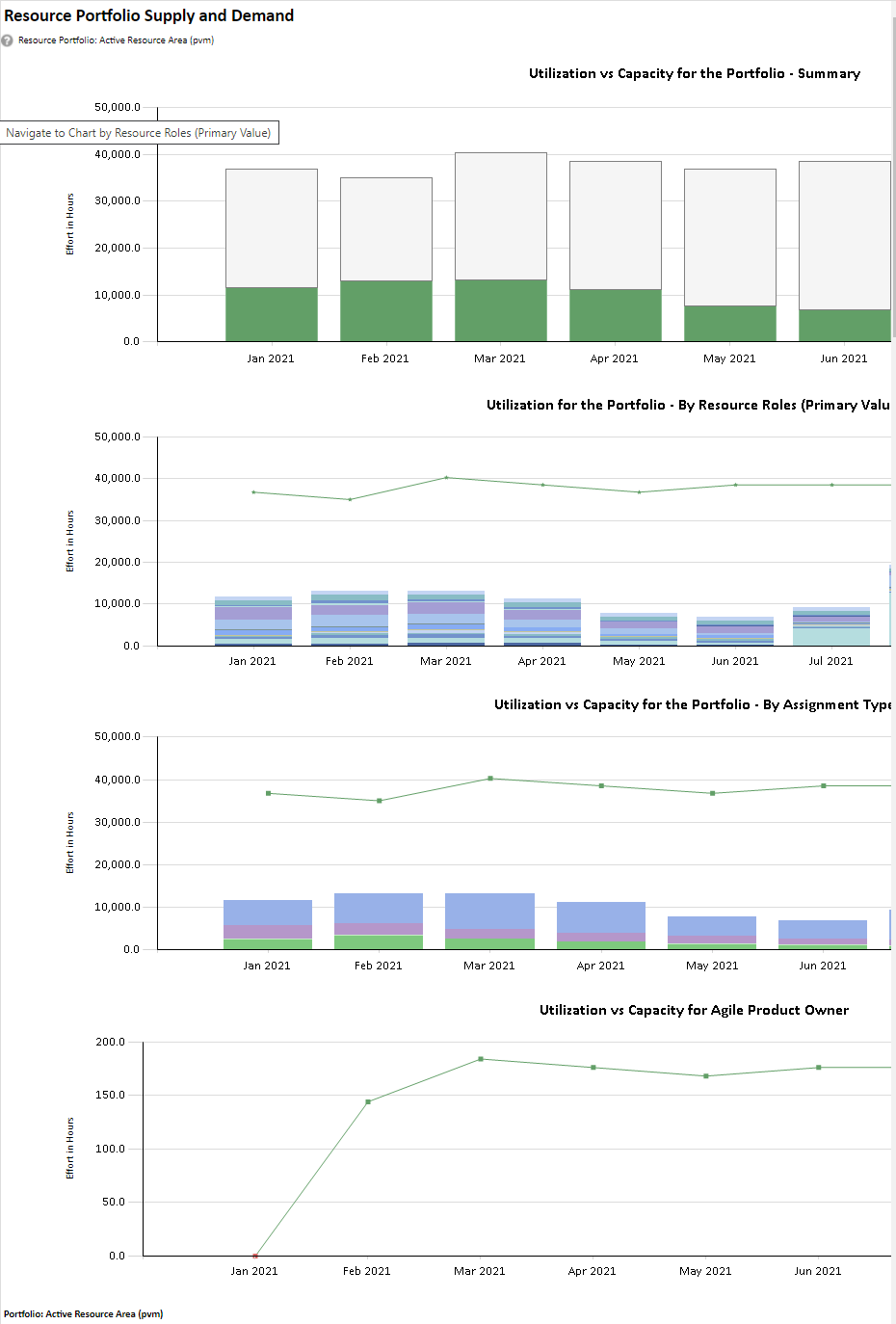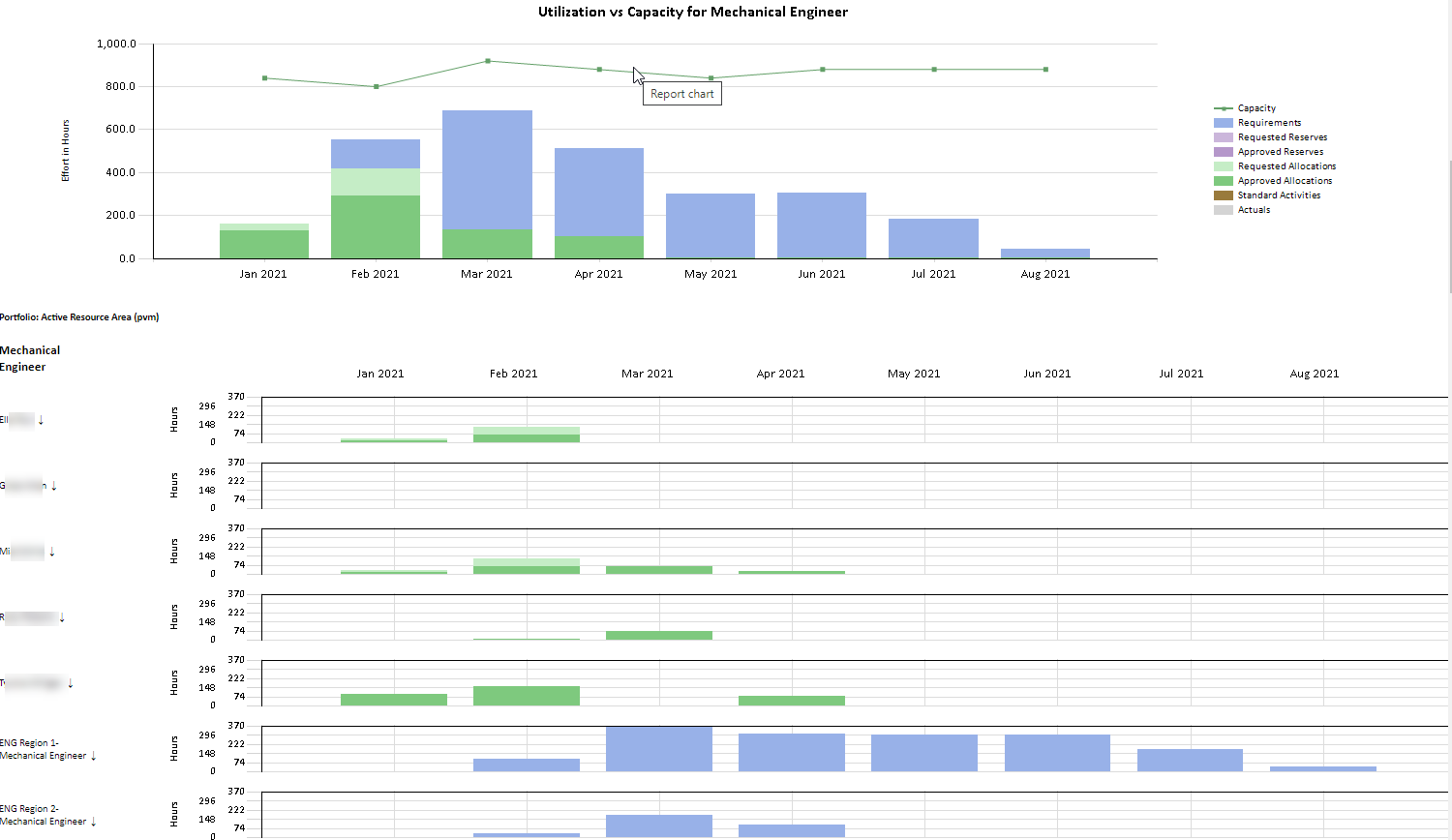RES03 - Resource Portfolio Supply and Demand
- Last updated
- Save as PDF
Overview
Organizational (through a resource portfolio) view of resource capacity and the demand against that capacity. The demand is based on requirements, reserves, and allocations in the project schedules. Data can be pivoted by different resource dimensions, time sliced in weeks or months, and displayed in hours, days, or FTEs.

RES03 Resource Portfolio Supply and Demand example

RES03 Utilization vs. Capacity example
Business Outcomes
- Predictability of project delivery knowing there is alignment of supply to demand.
- Identification of over and under loaded teams/resources with the ability to drill into the core application to make adjustments.
- Optimize Organization resource portfolio profiles for the Organization based upon forecast demand.
Supporting Capabilities
- Project Planning and Scheduling
- Capacity and Demand Balancing
- Resource Assignments and Utilization
Report Business Rules
- The data displayed by this report is based on:
- For the selected resource portfolio and time range, determine all demand (requirements, reserves, and allocations) assigned to the resources in the portfolio
- The report will respect the Work Status rules, only considering demand against work with work statuses that are not marked for “Suppress Assignments for Staffing”
- For historical/in progress periods actual effort is also included to reflect the total utilization (actual and scheduled) for the period.
TIP
There are no controls available to (directly) filter based on Investment Approval however this could be achieved indirectly via work status assignment suppression, or alternatively by using Investment Approval as the Slice By attribute. Be sure to include the Portfolio by Slicer Chart to see demand by Investment Status.
- Chart 1 - Utilization vs Capacity for the Portfolio - Summary:
- This chart provides a summary for the whole portfolio, showing all demand (utilization) compared to the capacity of all resources in the portfolio.
- When the total demand (utilization) across out-of-portfolio and in-portfolio projects exceeds the capacity of the resources then over utilization is identified (red).
- Chart 2 - Utilization for the Portfolio - By <Selected Slicer>:
- This chart provides a portfolio level summary of demand (utilization) vs. capacity and uses the Slice By parameter to provide an analysis of the demand by the selected slicer attribute.
- A capacity line is displayed, showing the capacity of all resources associated with the work in the selected portfolio/project.
- Chart 3 - Utilization vs Capacity for the Portfolio - By Assignment Type:
- This chart provides an analysis of the demand by the Planview Portfolios assignment type: Requirement, Reserve, Allocation, Actual.
- A capacity line is displayed, showing the capacity of all resources associated with the work in the selected portfolio/project.
- Chart 4 - Utilization vs Capacity for <Selected Slicer>
- This section of the report provides one chart per value of the selected slicer.
- Each chart shows the demand for each slicer value.
- The charts only show a capacity line when the selected slicer is a resource attribute. It is not possible to slice capacity by a demand (work) only attribute.
Report Parameters
| Parameters | Description |
| Slice By | A resource or work attribute can be selected as the attribute to analyze the demand (and where applicable) the capacity. Work attributes can be used as the slicer attribute in this report. When using work attributes as slicers the capacity is not sliced by the attribute, only the demand is. |
| Approval States | Status of assignments that will be included in the demand. Options are:
|
| Effort Unit | Unit of measure used for effort. Options are:
|
| Breakdown Effort By | Breakdown by Week, Month, or Quarter time slices in chart or table. |
| Range Start/End | Date range that is used to determine demand and capacity returned. |
| Include Demand against "Unassigned" Org Res? | Determines whether unassigned demand is included in the report. Options are:
|
| Show | Controls which charts and tables are displayed in the report. 6 Options are available for selection:
|
| Include Out of Portfolio Demand |
NOTE This parameter is not applicable to this report when run as RES03 against a resource portfolio.
|
| Detail Table Format | This parameter determines the format of the detailed data table in the report. Users can select a formatted layout, with grouping either expanded or collapsed, or a plan, flat-table, format that is designed for use when exporting the report to Excel for further data analysis. Options are:
|
Additional Information
Based on the parameters used (resources in the portfolio, time range, and time slicing) this reports lifts a lot of data, therefore extending run times should be expected.


